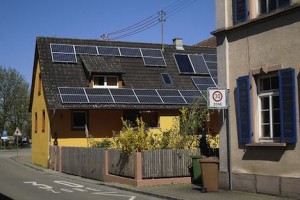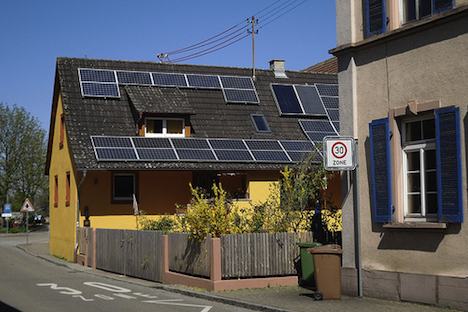After the Fukushima Daiichi nuclear power plant meltdown the government of Germany pledged to eliminate nuclear from its energy mix by shutting down 8 plants immediately and the remaining 9 by 2022. Did this Germany would go back to coal-fired or natural gas power plants?
Not so. Germany, based on the latest data, appears to be building its renewable energy capacity quite rapidly. Today it leads the world in solar power generation and its no slouch when it comes to wind either. In July of 2011 Germany actually had to pay customers to remove power from the grid when its wind farms pumped out nearly 12,000 megawatts of power with wind speeds averaging 15 kilometers (9.3 miles) per hour. And in the last few months German solar generated power has come close to 20 Gigawatts of power generated during daylight hours. In the last week for the first time German solar generated more than 22 Gigawatts of power at mid-day. It wasn’t a workday and as a result met close to 50% of the entire country’s mid-day electricity needs. The ability to generate numbers exceeding 20 Gigawatts represents solar capacity growth of better than 50% in the last year with 26 Gigawatts currently installed, as much as the rest of the world combined.
The challenge for Germany remains one of creating a stable supply of electricity from these renewable sources. That will only be accomplished when solar and wind are integrated with inexpensive and reliable storage technology that can capture excess power generated and feed it back into the grid when solar and wind are unavailable.
Using solar and wind has produced a carbon emission benefit with the country on track to reduce its carbon footprint by 40% from 1990 levels by 2020.











I have been doing some research on solar panel and wind tubnire systems. The pricing is crazy. For a 10Kw solar grid tie kit system is between $35,000 and $40,000. If you install batteries add $3,000-$5,000. 10Kw will only power a small to medium home without electric heat. Using my electric usage and info from my local electric company payback is 60 years for solar and 361 years for wind. This is unexceptionable. The manufactures of the solar and wind are gouging the consumers. They are using the excuse of supply and demand for the high cost. When demand goes up so will mass production and the price will go down. This is true, but they are making a huge profit on what they are making now. Some items are in the 3000% markup range. Are the power companies keeping the price up so their profits don’t suffer? My local electric supplier has an ENERGY PARK that you can go see solar and wind power in action and check out real time data online. They have a 4Kw solar array installed and claim it cost $30,378 installed and a 2.5Kw wind tubnire that cost about $20,000 installed. I think they are giving false numbers to consumers so you won’t go green. I was able to find a 3.5Kw kit online for $9,000. This doesn’t include any type of mounting materials. You can add $800-$1,200 for these materials. An installer will will charge you $2,000-$4,000 to install it. For the sake of argument lets say this will cost you $15,000 to install but still way out of line for you and me to install. That is a far cry from the $30,000 the power company claims. The power companies don’t want you to make your own electric. They are keeping the cost high so they will still make money off you. A 210w panel sells for around $600. They probably manufacture it for under $50. The cost needs to be $100-$150 to the consumer to make it affordable to the average home owner. 50 210w panels make a 10Kw system. That would be $5,000 not $40,000. The manufactures are raping us and the power companies are helping them to keep prices high. When will we get the technology at a proper cost? Let me know what you think.In response to the first 5 answers, Yes, if demand increases so will mass production and thus supply will increase and this will drive the price down. I looked into panels from China. From what I was able to find panels sell for $0.17-$0.45 per watt. In the U.S. they sell for $3.00-$5.00 per watt. Manufactures in the U.S. have lobbied for a higher tariff on solar products that makes them impractical to import on mass. These companies want to keep the price high so their profits stay high, and the power companies do not want you to produce all your own power. That would put them out of business.In response to Steve R, You need to do more research before you post another retarded comment like that. Air DOES have mass (just not very dense). When air is in motion it is called WIND . This motion creates energy. Have you ever heard of a tornado ? Get your facts together next time.
Hi Rajesh, For suppliers of solar panels the biggest problem has been mitigating their investment in inventory in the face of rapidly declining costs, stuck with inventory that they have to move at a loss. At the same time utilities are struggling to integrate standalone solar residential into their grids. You would have thought that with governments providing incentives for moving to renewables that the utilities would have made provision for rolling meters backward but it appears that is not the case.
As for the investment in wind turbines we continue to see large-scale installations by utility providers but little in the way of small-scale residential. Yet we have seen windmills on farms for years. It seems to me we have forgotten more than we know.
Ultimately it is the combination of wind, solar, storage and inverter technology that will make renewables the energy generating standard for commercial and residential units. But the industry needs a solution provider to provide that turnkey at a reasonable price, or provide it as a service offering that is leased to the user the way hot water tanks are rented to homeowners here in Toronto today.